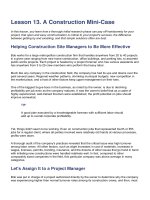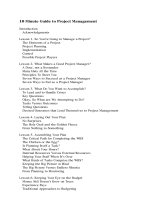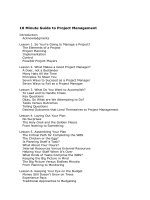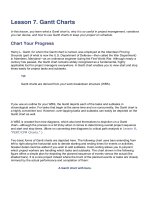10 minute guide to investing in stocks
Bạn đang xem bản rút gọn của tài liệu. Xem và tải ngay bản đầy đủ của tài liệu tại đây (734.42 KB, 248 trang )
I l@ve RuBoard
Front Matter
Table of Contents
Index
About the Author
10 Minute Guide to I nvesting in Stocks
E. Saenz
Publisher: Alpha Books
First Edition September 01, 2001
ISBN: 0-02-863610-4, 216 pages
New investors can fall into some dangerous traps. If you are new to the stock market, if you need a refresher
course in investing basics, or if you are an employee of a corporation that manages its own profit sharing stock
plan, this easy-to-use reference guide on everything from research to mutual funds can help you. It provides a
basic education on stocks, investing, and the way the market works. >
I l@ve RuBoard
I l@ve RuBoard
Front Matter
Table of Contents
Index
About the Author
10 Minute Guide to I nvesting in Stocks
E. Saenz
Publisher: Alpha Books
First Edition September 01, 2001
ISBN: 0-02-863610-4, 216 pages
New investors can fall into some dangerous traps. If you are new to the stock market, if you need a refresher
course in investing basics, or if you are an employee of a corporation that manages its own profit sharing stock
plan, this easy-to-use reference guide on everything from research to mutual funds can help you. It provides a
basic education on stocks, investing, and the way the market works. >
I l@ve RuBoard
I l@ve RuBoard
10 Minute Guide to I nvesting in Stocks
Introduction
Extras
Acknowledgments
Lesson 1. Confronting Your Fear of Stocks
What You Need to Know Before Beginning
Technical-ese
Insufficient Financial Knowledge
Stocks Are Only for Millionaires
A Stock Market Crash
Is Investing Like Gambling?
It Will Take Too Much Time
Lesson 2. Why You Should Invest in Stocks
Stocks Rock!
Stocks vs. Bonds
Stocks vs. Cash
Stocks vs. Mutual Funds
Lesson 3. How Much Do You Have to Invest?
Determining Your Overall Financial Picture
Sufficient Savings
Getting Rid of Debt
Determining Your Expenses
Paper Investing
Lesson 4. What Is a Stock?
Stock Talk
What's a Company Worth?
Kinds of Stock
The Two Main Issues of Stock
Lesson 5. The Five Types of Stock
Stock Characteristics
Lesson 6. Stock Derivatives
What Are Derivatives?
Subscription Rights
Warrants
Options
Lesson 7. The Markets
Trading Places
The New York Stock Exchange
The American Stock Exchange
Regional Exchanges
Over the Counter
International Exchanges
The Big Bang
Other Markets
Lesson 8. Brokers and Brokerage Houses
Types of Stockbrokers
Role of Stockbrokers
Securities and Exchange Commission
Full Service Stockbrokers
Discount Stockbrokers
E-Brokers
Educate Yourself
Lesson 9. Opening a Brokerage Account
Getting Started
Cash Account
Margin Account
Lesson 10. How Much Stock to Buy and How to Buy It
Determining How Much Stock to Buy
Round Lots
Odd Lots
Determining How to Buy Your Stock
Market Orders
Limit Orders
Stop Orders
Lesson 11. How to Pick Stocks
Determining Your Objectives
Determining Your Acceptable Level of Risk
Inflationary Risk
Political/Governmental Risk
Market Risk
Lesson 12. Evaluating Stocks
The Dreaded Math Part Made Easy
The Price/Earnings Ratio
Lesson 13. Choosing a Strategy
Investment Strategies
Recommendations
Research
Buy and Hold
Dollar Cost Averaging
Constant Dollar Averaging
Lesson 14. How to Check Your Investments
Congratulations!
Reevaluating Your Portfolio
Checking Your Stock's Performance
Reading the Stock Tables
Miscellaneous Information
Lesson 15. The Ticker Tape, Stock Indices, and Other Media
The Ticker Tape
The Indices
The Dow Jones Average
The NASDAQ National Market System Composite Index
The Standard & Poor's 500
The AMEX Market Value Index
The NYSE Composite Index
The Russell Indices
The Wilshire 5000 Equity Index
Other Media
A. Glossary
Glossary
B. Resources
Credit Reporting Agencies
Financial Media
Brokers
Online Research
I l@ve RuBoard
I l@ve RuBoard
10 Minute Guide to I nvesting in Stocks
Copyright Information
Copyright © 2000 by Pearson Education, Inc.
All rights reserved. No part of this book shall be reproduced, stored in a retrieval system,
or transmitted by any means, electronic, mechanical, photocopying, recording, or
otherwise, without written permission from the publisher. No patent liability is assumed
with respect to the use of the information contained herein. Although every precaution
has been taken in the preparation of this book, the publisher and author assume no
responsibility for errors or omissions. Neither is any liability assumed for damages
resulting from the use of information contained herein. For information, address Alpha
Books 201 West 103rd Street, Indianapolis, IN 46290.
Library of Congress Catalog Card Number: Available upon request.
02 01 00 8 7 6 5 4 3 2 1
Interpretation of the printing code: The rightmost number of the first series of numbers is
the year of the book's printing; the rightmost number of the second series of numbers is
the number of the book's printing. For example, a printing code of 00-1 shows that the
first printing occurred in 2000.
Printed in the United States of America
Warning and Disclaimer
Note: This publication contains the opinions and ideas of its author. It is intended to
provide helpful and informative material on the subject matter covered. It is sold with the
understanding that the author and publisher are not engaged in rendering professional
services in the book. If the reader requires personal assistance or advice, a competent
professional should be consulted.
The author and publisher specifically disclaim any responsibility for any liability, loss, or
risk, personal or otherwise, which is incurred as a consequence, directly or indirectly, of
the use and application of any of the contents of this book.
Trademarks
All terms mentioned in this book that are known to be or are suspected of being
trademarks or service marks have been appropriately capitalized. Alpha Books and
Pearson Education cannot attest to the accuracy of this information. Use of a term in
this book should not be regarded as affecting the validity of any trademark or service
mark.
Dedication
This book is dedicated to Martin Saenz, who gave me my first dollar, and to Ed Saenz,
who taught me the rest of them wouldn't come so easily.
I l@ve RuBoard
I l@ve RuBoard
Introduction
The current explosion of the stock market is unprecedented by any period in its history. Since
the 1980s, the number of American households that own common stock has risen from
below 20 percent to just under half. And, this does not include households that hold stock
within their retirement plans or other indirect means. A significant portion of this growth is a
direct result of the proliferation of information available to the public through such new forums
as the Internet. Any information without explanation, however, is useless.
As a result, many people view the stock market as the domain of number crunchers who
speak in a foreign language and do things the average person couldn't begin to understand.
This lack of understanding often leads the person on the street into the arms of a financial
professional to manage his or her money. This in itself is not necessarily bad. Many people,
however, are surprised to discover that with a minimum of effort, they can become fully
qualified to handle their investments themselves, much as they handle their other finances. In
addition, people who have hired someone to manage financial matters for them place
themselves in a particularly vulnerable position if they do not have even the most rudimentary
understanding of how their money is being managed.
That's where this book comes in. The major aim of this book is to explain the basics of stock
market investing in language that is understandable to the reader. To that extent, this book is
full of comparisons to other everyday situations, anecdotes, personal experiences, and even
strange-but-true facts to keep you interested as you make your way through the wonderful
world of personal investing.
Like a map, this book will guide you through the investing maze while giving you a heads-up
for the things you should pay particular attention to, ignore, or use to determine your own
level of interest. This book is not intended to be a textbook nor a comprehensive reference,
but rather to give you more than sufficient information to get started as an investor. That in
itself has proven time and time again to be enough to whet the average investor's appetite to
know more. Good luck to you, and happy investing.
I l@ve RuBoard
I l@ve RuBoard
Extras
There are many things to learn before investing in the stock market. Use the vital information
in the chapters to guide you in your investment decisions. Scattered throughout the pages
are sidebars with useful information, definitions of financial terms, helpful tips, and cautions
to help you handle your investments.
Plain English
This sidebar defines investing terms and basic concepts.
TIP
Here you'll find tips on how to make investment decisions.
CAUTION
Take these sidebars seriously—they help you avoid investing mistakes.
I l@ve RuBoard
I l@ve RuBoard
Acknowledgments
There is no shortage of people who have helped me immensely in the writing of this book. I
am indebted and very grateful to them all. If I've forgotten anyone, please know that it is
unintentional. Thank you to Renee Wilmeth for having the patience of a saint and to Joan
Paterson who is hands down the best editor I've ever had the privilege of working with. A very
special thanks to Tony Vlamis, Florence Stone, and Tom O'Neil who believed in a young
business writer and gave me more opportunities and help than I can ever repay. Thanks to
mom and dad for their constant belief in and support of me. Thanks also to my brother, Art,
and sister, Tina, for having enough humor to let me use them as examples. Thanks also to
Tias Be-Be and Henri for betting on the dark horse.
I l@ve RuBoard
I l@ve RuBoard
Lesson 1. Confronting Your Fear of Stocks
In this lesson you will learn what stock market investing really entails as opposed to common
myths you may have heard.
I l@ve RuBoard
I l@ve RuBoard
What You Need to Know Before Beginning
Welcome to the world of investing in the stock market. You are about to join the ranks of a
very elite group of people, namely those who have decided to actively manage their own
money and make it work for them. This is a big step, and not one that should be taken
without sufficient preparation. Before beginning with the more technical aspects of investing
in the stock market, then, you should first ensure you have dealt with any mitigating
circumstances that might otherwise distract you.
TIP
Many outside factors, such as lack of cash and preexisting fears, may affect your
investment abilities and decisions. Learn about your fears before attempting to
invest.
The most obvious confounding circumstance would be lack of cash with which to invest. The
effects of this situation would probably be limited, however, to a lack of opportunity for profit.
Also significant would be a lack of understanding of how stocks compare with other
investments. That is explained here sufficiently to neutralize that fear.
More insidious, however, are the preexisting fears many people bring with them. These fears
can affect investment decisions up to and including the decision whether to invest at all. Here
are some common ones:
Fear of technical-ese
Fear that your financial knowledge is insufficient
Fear that investing is only for millionaires
Fear of stock market crashes
Fear that investing in the stock market is a gamble
Fear that investing is too time-consuming
Because these fears have the potential for damage, it's best to meet them head on. Face
your fears of the stock market directly by learning the truths behind erroneous information
you may have heard. You will then be able to place any reservations you may have had in
their proper perspectives.
I l@ve RuBoard
I l@ve RuBoard
Technical-ese
The stock market has a language all its own—street talk. Terms like zero-coupon bonds, net
asset values, and price/earnings ratios are absolutely guaranteed to draw a blank look from
the average person on the street. This shouldn't be surprising. Every trade, sport, and craft
has a certain number of terms or phrases that are unique to it. And, since language is
created by need, specific terms have arisen in each sphere to address this need for
description.
TIP
To deal with the fear of technical-ese, or the terminology used in the financial
community, keep in mind that as a beginning investor your need for learning these
terms is limited.
The terminology used in some areas, in sports for example, is familiar to almost everyone.
Most people know what a seventh-inning stretch, a free throw, and a touchdown are even if
they've never played or attended a game in their lives. However, in other areas, such as law
and medicine, the terminology seems confusing and technical, leading to the general
consensus that much schooling and substantial intellectual ability are required to understand
any of it.
Unfortunately, finance—which includes the stock market—has long fallen into that second
category. There could be several reasons why. Perhaps one is the fact that much of finance
involves math—and we all know how we struggled with that in high school. Perhaps it is
because Wall Street's conservative image makes us uncomfortable and thus we don't
pretend to understand what it's about and we are hesitant to ask.
TIP
While the sheer number of financial terms might be a little overwhelming, learning
them isn't as daunting a task as it might appear. Many basic terms are used very
frequently and will quickly become familiar.
For the longest time, and to some extent even today, the financial community was dependent
on mass ignorance to survive. For example, let's take the term "investment management."
This term means just that, the management of investments. Under normal circumstances, the
average person certainly wouldn't trust someone else to take care of everything he or she
owned. So, investment managers, brokers, and financial analysts regularly tossed out terms
that they knew their clients wouldn't understand. Since no one wanted to appear stupid, the
clients would simply nod their heads a lot and be grateful that someone was around who
could interpret all these obscure terms. By intimidating their clients this way, investment
managers kept their clients from realizing investment management was little more
complicated than the management of their household finances, which the clients were
already doing themselves. Should the masses ever wise up and begin to manage their
investments themselves, the jobs of the investment managers would disappear.
In all fairness, however, there are a significant number of specialized terms used in the stock
market—the world of finance has to be described somehow. The financial community is
directly involved in almost every aspect of every person's life on the globe today; it employs
hundreds of millions of people and is comprised of every industry in existence. Trying to
describe all that this includes is going to take a lot of words. But, happily, you certainly don't
need to know all the terms in order to be a successful investor. I am a longtime professional
financial writer, and I still look things up. All you need to learn are the terms that are relevant
to you. And this book is a good place to start. In addition, by gaining a working knowledge of
investment terminology, you will be able to manage your own investments should you choose
to, just as you manage your own household finances and paycheck. After all, who is better
equipped to make decisions regarding your money than you?
As the terms rise in complexity, they are less familiar even to seasoned financial veterans.
For example, the percentage of customers in a bar who order a basic drink like a martini will
be pretty high. In much the same way, certain words will prove to be the basis for describing
your particular financial investments. When a customer orders something strange like a
Screaming Viking, the bartender will need to look up that drink recipe or simply ask the
customer what is in it. Similarly, when hit with a term you don't understand, you can either
look it up or ask someone to explain it to you. By the way, don't be embarrassed to do this. I
haven't met anyone yet who doesn't love the opportunity to expound on what he or she
knows about stocks. Also, you'll never need to ask again.
I l@ve RuBoard
I l@ve RuBoard
Insufficient Financial Knowledge
Not understanding the workings of financial markets, such as the stock market, is
comparable to not understanding financial terms, but the potential for getting into trouble is
much greater. A lack of knowledge when you invest in the stock market can get you
financially wiped out. Here are two tips for obtaining the knowledge needed to be a
successful investor:
Up to now you have probably had little or no reason to learn about the workings of the
stock market. Until the time I decided to take sky diving lessons, I couldn't have told you
at what altitude the cord must be pulled. Before I took my first plunge, however, I assure
you I was very sure of when I was supposed to pull my chute. In much the same
fashion, you should learn everything you can before taking the investment plunge.
1.
As with the technical terms, you only have to learn the workings of those investments
that pertain to you.
2.
TIP
If you feel intimidated by financial information, the best way to deal with it is to
casually scan through the financial media. Pick up a copy of The Wall Street Journal
or watch Moneyline on TV. You'll be surprised to discover that you understand a lot
more than you thought you would.
This book is designed to explain the internal processes of the stock market that are relevant
to you the investor. It will not overwhelm you with extraneous information but instead will give
you the essential information you need to know to get started as an investor. Over the years I
have learned such informational tidbits regarding the workings of the stock market as how
stocks are coded into various classes, how trades are settled, and how to recognize the
various functions of the floor traders from the colors of their coats. All of this is certainly
interesting and often fun information; however, the color of a floor trader's coat will in no way
help you make intelligent investment decisions.
There's an old phrase that sums up expertise quite nicely, "Everything is easy … if you know
how." With that in mind, this book attempts to explain some of the more esoteric functions in
terms and with examples that are familiar to the average person. The real responsibility of
understanding these functions, however, is up to you, the individual investor. This is
important because, as like any industry, the stock market has unscrupulous people who prey
on uninformed investors. The golden rule of investing, therefore, is "Know what you are
getting yourself into." Only by arming yourself with knowledge can you ensure that you will
not be taken advantage of or make a bad decision.
It's Not That Difficult
Fortunately, expanding your financial knowledge is not hard. Repeated exposure will make
many of these things increasingly familiar. So, here are some good ways to increase your
knowledge:
Listen to the financial news.
Look at the stock pages.
Check out financial Web sites.
Do these activities even when you do not understand what is being discussed. Initially, this
may prove a little frustrating, but over time you will begin to develop an understanding that
will become your knowledge base. Soon you will be able to ask the appropriate questions
needed to gain a fuller understanding.
In addition, don't try to learn every aspect of every financial vehicle in every market in the
world. The terminology is massive, because the financial marketplace itself is massive. Start
out small and work your way up. The focus of this book is stocks and their corresponding
markets. Save learning about the bond market until next week and foreign currency
exchanges until the week after that. Eventually it'll all come, you'll see.
CAUTION
Remember that your own money is on the line. If an investment is worth your hard-
earned cash, then it's certainly worth taking the time to understand all the
information available on your investment.
Finally, and most important, if you don't understand something, either look it up or ask. It is
absolutely imperative that when you first learn about the stock market, or the greater financial
community, that you fully understand the basics. Subsequent information will grow
increasingly complex and most, if not all, of that information will be based on the assumption
that you are already familiar with the more basic processes. If you are not, the potential for
disaster is greatly increased. Also, even in the more complex processes, ask for clarification
of anything you don't understand. Chances are if you don't understand it, others haven't
understood it either.
I l@ve RuBoard
I l@ve RuBoard
Stocks Are Only for Millionaires
The belief that stocks are only for millionaires is probably the most common reason why
people avoid the stock market. There is a circular train of thought that says that the reason
people believe that stocks are only for millionaires is because everyone who buys stocks
eventually becomes a millionaire. If only this were true … the reality, however, is substantially
different. This impression is probably based on the numbers bandied about in the financial
markets.
Initial investments in mutual funds currently average $2,500.
Minimum purchases of municipal bonds can total thousands of dollars.
A hundred shares of Coca-Cola would cost about $4,400 right now.
Such large amounts are frightening to many people. And, should the average person receive
a windfall of $4,400, quite frankly a trip to Disney World would probably precede the
purchase of a hundred shares of Coca-Cola.
The irony is that the very people who should be investing in the market are not, for these very
reasons, doing so. The investor who can buy a hundred shares of this or that without a
second thought is probably so rich that investments are the last thing he or she needs to
worry about. On the other hand, the average person on the street—that is, you and I—needs
to take a very different approach to investing.
Fill the Bucket Slowly
This book explains in great detail several strategies for investing minimal amounts on a
regular basis. For right now though, consider your beginning investing attempt as filling a
bucket under a dripping faucet. The rich person over there is the only person who can afford
to pay the water bill this month. As a result, he or she can turn on the faucet and fill up the
bucket in a matter of seconds. Since we poorer people can't afford the water bill, we are
resigned to filling up our bucket from the drops that are falling from the turned-off, but leaky,
faucet. While our method will certainly take more time, in the end it will yield the same results
as turning on the faucet. Translate this to money instead of water, and you can see the
advantages of constantly dripping small amounts into your investments. In the end, you and
the rich person will both have a bucket of water … make that a bucket of money.
TIP
One fear is that the stock market is geared to big investors and that the average
person doesn't have enough funds to actively participate. Deal with this fear by
discovering the many investment options that are designed to accommodate people
at any financial level.
Like many of the reasons you and other potential investors have for not investing, the
concern of not having "enough" money to invest is not new. Fortunately, the financial market
is a place of business, and as such it continually modifies itself to attract new investors. Many
programs have been created to accommodate new investors having little or no available
cash. These are not scams; they are honest attempts to accommodate the situation of the
majority of the American public.
Frankly, most people don't have a couple of thousand dollars lying around. So,
accommodations exist for people who wish to purchase one share of stock or invest the
same amount into a monthly stock purchase. Direct deposit programs can ensure that
investment amounts are deducted before the balance is deposited into a checking account.
Many brokerage firms periodically reduce the initial amount required to open an account
through the use of "sales." Of course you will have to do a little poking around to see what is
available out there. As a general rule, however, few companies will refuse your money.
Fill the Bucket Regularly
The trick to investing with little money is to begin by putting money away regularly. Give the
money to a friend or family member, or, better yet, open a savings account and direct deposit
some of your paycheck into that account. Put it under your mattress if you need to. When the
amount rises to the level of a minimum investment, transfer the money then. Virtually all
investments like stock purchases will accept subsequent investments in much smaller
amounts (often $50 or $100).
This strategy of small but regular deposits can be really distasteful at first. Once the decision
to invest has been made, you, like most investors, will probably want to see progress
immediately. Many investors are even disappointed enough by this inertia to abandon their
investment careers. But, like the dripping faucet example, the bucket will eventually be filled.
Delays in making deposits will only prolong the time needed to fill the bucket.
Finally, be aware that many of these programs and opportunities have, in fact, enticed a
number of "average" people to invest in the stock market. Roughly 20 percent of the
American population, or 40 million people, currently own stock. And this figure does not even
include the people who own stock indirectly through a program such a retirement account.
You are not alone in the market, nor are you an inconvenience to those who are already
invested. The participation of individual investors is critical to the market's success and, as
such, they will be accommodated.
I l@ve RuBoard
I l@ve RuBoard
A Stock Market Crash
Many people are frightened by the stock market because of the stories about past market
crashes. Yes, those crashes did happen, but the fear surrounding them is more hype than
substance.
TIP
Your fear that the market will collapse as it has done in the past is best dismissed by
learning that the probability of another crash is infinitesimal and that the damage
caused by previous crashes was not as bad as the public's perception of them.
On October 29, 1929, the Dow, a measurement of the stock market as a whole, fell 30 points
to close at 230.07. This represented a drop of almost 13 percent in the whole market. The
loss of market value was roughly $14 billion, a staggering sum even now. This meant that
$14 billion of the total amount invested into the market by people and by entities such as
pension funds was simply gone. The severe ramifications of this event affected even those
people who had not actually invested in the market. The subsequent depression, while not
directly a result of the stock market crash, further entrenched the idea that investment in the
stock market would later reduce the investor to selling apples on a street corner while
wearing a barrel. Finally, the stories and depictions of grown men throwing themselves off
roofs and crying at their desks assured the general masses that stock investments could only
cause heartache.
In addition, 58 years later, the crash of 1929 was surpassed by Black Monday and Black
Tuesday on October 19 and 20, 1987, respectively. The Dow's drop of 508 points
represented more than a 22 percent drop in the total value of the market and over $500
billion of investor dollars. The crash of '29 was a picnic by comparison.
These events have been highly analyzed, and rational and reasonable explanations for both
crashes have been presented and generally accepted by the marketplace. The crash of 1929
was attributed to the market's practice of accepting credit to pay for stock purchases. That
practice has long since been cancelled. In addition, program trading, or the ability to trade
stocks in a matter of seconds through the use of computers, has been blamed for the crash
of 1987. Both of these explanations are probably not particularly important, however, to the
people who owned stock at the time of the crashes. The focus is not on why the money was
lost, but on the fact that the money was lost.
Two things are important to remember in attempting to place investors' fears in the proper
perspective in light of these unfortunate events.
The most obvious is that the crashes are infrequent events. Twice since the inception of
the stock market in 1792 is not a bad track record. Your chances of being involved in a
stock market crash are slim to none. Once invested in the market, you will come to
realize that the likelihood of a market crash is so infinitesimal as not to be a concern
anywhere in the financial community. By sharing in that confidence, you will be able to
discard your fear altogether.
1.
Persistent new investors will continually ask, "But what if …?" After all, a chance, no
matter how small, of the market's crashing does exist. This question has arisen as a
result of the recent collapses of the Asian and Russian markets. It should be pointed out
that while markets around the world were crashing, often as a result of the ramifications
of prior crashes in other countries, the American market remained stable. The American
economy is 16 times larger than its next-largest competitor, a fact that lends an
incredible amount of stability and strength to American stock markets. Crashing them
simply isn't that easy.
2.
In the highly unlikely case that the markets do fail, remember that in both crashes the
average investor may have suffered heavy losses but was not wiped out totally. A loss of 12
to 22 percent of your initial investment is without a doubt disastrous, but it simply isn't that
significant when compared with the amount of money that the investment probably had
made. In the same train of thought, both of the crashes were preceded by extended
favorable, or bull, markets.
Happily, the history of the stock market has taught us that bull, or favorable markets tend to
last longer than bear, or unfavorable, markets. The term "bull" market was taken from early
bear trappers. They were notorious for depending on the price of fur to drop so they could
purchase pelts cheaply to cover prior options trades they had made. A popular sport at the
time, bull and bear baiting, depicted the bull and bear as natural enemies, so the term bull
market was used to describe the opposing rising market.
Plain English
The terms bull market and bear market are used to describe the conditions of the
market. Extended periods when stock prices continue to rise are referred to as bull
markets, and periods when stock prices fall are known as bear markets.
In 1929 the stock market had reached a new high of 469.49 the month before the crash. In
1987 the stock market had also reached a new high of 2,722.42, two months before the
crash. It is safe to assume, then, that a significant portion of the money being lost by
investors was the profits that they had made from their investments. This doesn't mean that
their losses weren't real, however. If at the end of the day you still have the money you put
into the investment, it is difficult to say you lost anything other than the time that your money
was occupied and, of course, any opportunities which were missed as a result of it.
Many fears may be somewhat justified. To not invest because you fear a stock market crash
is not one of them.
I l@ve RuBoard
I l@ve RuBoard
Is Investing Like Gambling?
Investing in the stock market is not gambling. True, both do attempt to accurately predict
future outcomes, but the similarities end there. The inherent fear in gambling is that the
outcome is determined by something over which you have no control and understand even
less—a pair of dice for example. This is not the case in the stock market. In the stock market,
investment decisions are made after a careful analysis of the available information. For
example, let us say you receive a windfall of $100.
Option 1:
You don't have any real need for that money right now, and you sure wouldn't mind trying to
make that money work itself up to a bigger sum. You could place a bet on the roulette wheel,
in which case the fate of that $100 would depend entirely on your ability to predict random
probability. Regardless of how much research you put into that prediction, the end result
once the ball began to roll would be determined by nothing more than sheer chance. That's
pretty risky.
Option 2:
Investing in stocks works a little differently. Once purchased, a stock represents a partnership
between its issuing company and its investor. The investor has agreed to buy into the
business and, in return, the issuing company has agreed to try to increase that amount by
using it to improve the business. You want the company to succeed; the company wants to
succeed. Where is the gamble in that?
Choosing which partnership you want is also not gambling. The research involved here is not
an attempt to understand a science like random probability; it is designed to increase
familiarity with the company. Think of it like a job interview. During the interviewing process,
at one point or another you will be introduced around the office while you take the tour. In this
way, you can decide whether this company is one for which you would feel comfortable
working. In the same way, information on the issuing companies is made available so you
can decide whether this is a company in which you would feel comfortable investing.
TIP
The fear that investing in the stock market is reliant on chance is proved wrong as
new investors learn that the processes and tools with which they pick stocks are not
based on random chance but on intelligent research and decision making.
The inherent difference between gambling and investing is ultimately control. By gambling
your money, you have handed over control of it. The fate of your money rests on something
over which you have no control—the hopes that it will manage your money better than you
through the magic of probability. By investing, you are charged with the responsibility of
learning which stock will best manage your money in a manner consistent with your stated
preference. You directly control the company with your vote, and you can revoke your
partnership at any time. Because you are appropriately informed, the decisions are not left to
chance.
I l@ve RuBoard
I l@ve RuBoard
It Will Take Too Much Time
Initializing and subsequently diversifying your portfolio should never take up an inordinate
amount of your time. Even as you expand your portfolio and begin to include other financial
instruments, a process known as diversification, the initial purchase of stock will be your
decision. Should you decide to spend hours researching, you are perfectly free to do so. Or,
you might ask a friend to give you advice. You decide to purchase the stock for whatever
reason you consider important. Research is never required.
Plain English
A portfolio is a collective term for all your investments. It should consist of cash as
well as different kinds of investments, such as stocks and bonds. Determining how
much of each you want is a process known as diversification.
After purchasing the stock, even monitoring its performance is optional. Should you decide
you want to know the stock's performance for the day, through the use of several methods
described in this book, you will be able to uncover any information in a matter of seconds.
But most important, you still control the amount of time you allot to monitoring your stock's
performance. Monitoring your investments is also not required.
So the total time commitment is solely your decision. That doesn't mean you shouldn't take
the time to learn anything. You obviously have some interest in the stock market, or you
wouldn't want to invest in it. As with other areas that catch your attention, you should take
some time to learn more and to become increasingly familiar with the market.
What inevitably happens is you start to become interested. Once you've learned how stocks
work, you start to wonder how bonds work. In addition to stocks you already own, you begin
to check the daily performance of stocks that you are considering purchasing. After learning
the business of one company, you become interested in how the competition is being run. As
your interest in finance expands, it is highly possible that you may find yourself putting more
time into it. However, this is your choice. The reverse is also true: Should you have no
interest in your investments or later lose interest, you are free to ignore the whole lot.
TIP
The fear that managing your portfolio will consume too much time is dismissed
when new investors discover that research is available but not necessary and that
they control the amount of time they want to devote to research.
As your holdings grow and expand, the amount of time you dedicate to learning about new
investment vehicles and to monitoring your expanded portfolio will also grow, but only
infinitesimally since the entire process requires only a few seconds in the first place. You
could continue to invest in the vehicles with which you are already familiar and thereby
further reduce additional time commitments. Or, you can begin to learn about alternative
investments at your leisure.
Like any commitment you make, investing will take up some time, but how much depends on
your decision. The truth, however, is that by the time you have so many stocks that
maintaining them is actually causing you time problems, you should be rich enough to afford
to pay people to do that for you.
The 30-Second Recap
Financial terminology should not be intimidating.
The basics of the stock market are not complicated.
Investment options exist for people of any income level.
The market is a safe stable place to put your money.
The stock market is not a game of chance.
The time required to manage your investments is minimal.
I l@ve RuBoard









